The report estimates that India’s steel and cement decarbonisation will require more than 80% of the total climate investment
India wants to achieve net zero by 2070. In order to achieve that, rapid decarbonisation across key industries is required. However, it needs to grow rapidly, so there is a necessity to balance out economic growth needs with decarbonisation goals.
That’s where climate finance can be a huge help. A new paper from the Centre for Social and Economic Progress (CSEP) and Task Force on Climate, Development and the International Monetary Fund estimates that India needs around $467 billion climate finance by 2030 to decarbonise its high-emitting sectors.
This translates to roughly $54 billion annually, or 1.3% of its GDP.
The paper analyses four major carbon-emitting sectors in India—power, steel, cement and transport—that contributed more than 50% of carbon dioxide emissions in the country in 2023.
High-emitting sectors barrier to decarbonisation
Among the high-emitting sectors, steel and cement are the most costly to decarbonise. The report estimates that India’s steel and cement decarbonisation will require more than 80% of the total climate investment. The high cost of these is due to the necessity of carbon capture and storage (CCS) technology, which is expensive.
The paper finds that decarbonising the power sector isn’t too expensive, and stands at $57 billion.
“The incremental financial resources needed for climate change mitigation in India for four key emitting sectors: energy transition, steel, cement and road transport, at an annual average of 1.3 percent of GDP up to 2030, are within reach. These sectors amount to over 50 percent of total carbon emissions. Contrary to most astronomical estimates that are done top down, this estimate has been derived on a bottom up granular basis. It provides a basis for optimism on our financial capacity to tackle climate change,” said Rakesh Mohan, one of the paper’s authors.
Reliance on domestic and foreign sources for climate finance
The study found that India may have to rely on foreign and domestic resources for climate finance. Expanding its current deficit up to 2.5% of GDP to absorb climate finance will also be helpful.
Other necessary steps would include incentivising private investment in the hardest-to-abate sectors of steel and cement, where decarbonisation costs are highest. The paper suggests that through subsidies and support for technology transfer and research to develop affordable solutions, these sectors will become cheaper and easier to decarbonise.
In the transport sector, accelerating electric mobility through enhancing charging infrastructure and regulatory measures would go a long way in cleaning it up. For power, stabilising and strengthening the grid combined with build up of renewables, battery and pumped storage would be helpful, according to the paper. The capital costs of these are lower compared to fossil fuels.
“The study provides a granular understanding of climate finance requirements of India’s four major carbon emitting sectors—power, road transport, steel and cement. Contrary to the common narrative, the study finds that it is not the power sector, but the steel and cement sectors which need large climate finance. Both the steel and cement are hard to abate sectors, which require the use of an expensive carbon capture and storage (CCS) technology, but it is the only feasible option at this stage,” said Janak Raj, another author of the paper.
·

